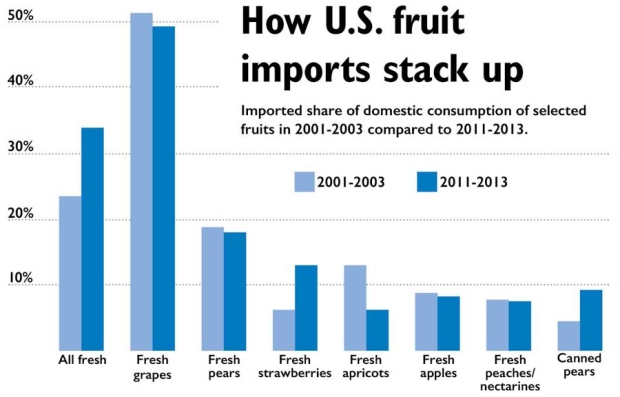Imports continue to account for an increasing share of fresh fruit eaten by U.S. consumers.
On average, one-third of all fresh fruit consumed in the United States from 2011-2013 was imported. This represented an increase of over 10 percent in market share compared with a decade earlier, 2001-2003 (see chart).

Source: USDA, Economic Research Service. Fruit and Nut Yearbook online, detailed tables. (Jared Johnson/Good Fruit Grower)
Much of the increase in fruit imports has been due to the growing popularity of exotic or tropical fruits not produced in the United States, such as mangoes, papayas and pineapples. However, even in the case of table grapes, about half of domestic consumption is still supplied by imports.
The share of fresh apples imported actually fell slightly between 2001-2003 and 2011-2013 as the U.S. apple industry has continued to expand the volume and diversity of apple varieties available in the late season to compete against apple imports from the Southern Hemisphere.
The proportion of fresh pears supplied from imports also has fallen slightly in the last decade, but at 18 percent it is still more than twice that of fresh apples.
The picture is not so reassuring for processed products. The share of apple juice and cider supplied from imports (not shown in the chart) has risen in the decade from 75.5 to 82.7 percent, while the share of canned pears imported has doubled from 4.6 to 9.3 percent.
In general, to compete in the U.S. market, foreign exporters of fresh apples, pears and sweet cherries have been upgrading the consumer appeal of the products they ship through improved quality, tighter grade standards and more varietal innovation, and they have been garnering much higher prices than in the past.
However, U.S. producers have more than matched these achievements. U.S. exporters of fresh apples have increased the volume of exports by 67 percent between 2001-2003 and 2011-2013 and the average price by 87 percent.
Pear exporters have increased volume by 16 percent and average prices by over 83 percent.
Sweet cherries differ from apples and pears in that virtually all imports come from the Southern Hemisphere (mainly Chile) in the winter months and do not overlap with the domestic shipping season. In that case, the U.S. has been able to expand both its exports and imports dramatically — exports by almost 100 percent and imports by over 70 percent.
Outlook for fresh fruit imports
For most U.S. producers, packers and marketers of fresh apples, pears and sweet cherries, the history of imports is not as important as is the outlook for the next decade.
To analyze this, we attempted to measure the response of fruit imports both to the competition from domestic supplies and to general economic conditions in the U.S. market. As one might expect, imports were higher in any season when there were temporary shortages of domestic supplies.
For fresh apples and fresh pears, increases in U.S. per capita incomes had no significant effect on the volume imported. For sweet cherries, the influence of increased incomes was positive, but relatively weak. So, increases in U.S. incomes will have limited impact on imports of fresh apples, pears or sweet cherries.
While Chile dominates imported supplies of sweet cherries, that country has experienced wide fluctuations in its available supplies due to rapid growth and weather variations.
For most of the last decade, the U.S. dollar was weak relative to currencies like the pound sterling and the euro, so Chilean exporters reduced the share of exports going to the U.S. market. When the U.S. dollar weakened, Chilean sweet cherries went to other countries.
However, in the case of imports of all fruit, their share of U.S. domestic consumption has tended to increase as U.S. per capita incomes increased. Each 10 percent increase in U.S. per capita incomes was associated with an almost 8 percent increase in the import share of all fruit consumption.
Implications
Our analysis suggests that U.S. fresh apples, pears and sweet cherries face little direct threat from foreign suppliers of their own products in the U.S. market.
Indeed, all are formidable net exporters. However, they face a very real threat from imports of competing fruits as U.S. consumers continue to switch from traditional deciduous fruits to an increasing range of tropical, exotic or specialty fruits and berries.
If per capita incomes in the U.S. continue to increase in the next decade, the share of imported fruits in U.S. consumption is also likely to increase. A major challenge for fresh apples and fresh pears will be preventing further erosion of their share of U.S. fresh fruit consumption.
– by Desmond O’Rourke, Ph.D., president of Belrose Inc. in Pullman, Washington, and publisher of the monthly World Apple Report. •






Leave A Comment